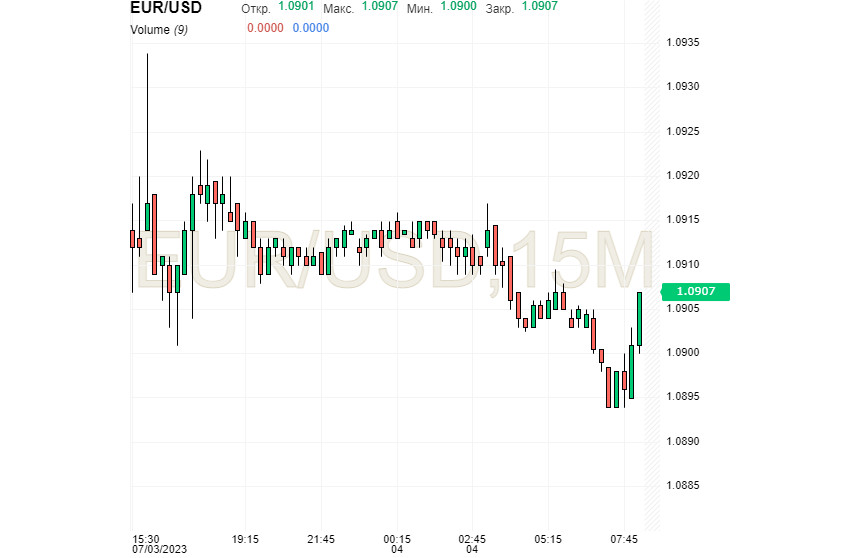See also


 04.07.2023 09:23 AM
04.07.2023 09:23 AMCurrently, the euro is struggling to stay afloat and avoid sliding to low values. Periodically, the euro makes a comeback, but the US dollar proves to be stronger. At the moment, the euro maintains a relative balance, but it faces significant difficulty overcoming the pull of the downtrend.
On Monday, July 3, during the day, the European currency weakened against the American currency after the release of eurozone economic data. According to the latest reports, the Purchasing Managers' Index (PMI) for industrial production in the EU decreased to 43.4 points in June from 44.8 points in May. The preliminary forecast predicted a decrease to 43.6 points.
The start of the current week was relatively positive for the euro. The single currency was trading near two-month highs but quickly lost its upward momentum. In this situation, the euro is at risk of further decline towards the key level of 1.0800 and below if US economic data supports the strengthening of the dollar. The European currency, which initially gained ground this week, remained afloat on Monday, July 3, but later lost momentum.
On Tuesday morning, July 4, the EUR/USD pair was trading near 1.0907, surpassing the pull of the downtrend. Preliminary estimates suggest that the pair will remain within a broad range of 1.0920-1.0750 this week.
According to the technical chart, the bullish momentum in the EUR/USD pair is gradually weakening, although bears are hesitant. Experts have identified a neutral-bearish bias in the pair and a lack of significant buying interest from investors.
Against this backdrop, the US currency has demonstrated a positive trend, gaining value against most competitors, primarily the euro. Market participants responded positively to reports on US inflation, which indicated a significant decrease in price pressure in May. The annual inflation rate, as measured by the Personal Consumption Expenditures Price Index (PCE), stood at 3.8% on a yearly basis, showing the smallest increase in the past two years. As a result, the greenback faced moderate selling pressure as market sentiment improved and investors shifted their focus to high-yield assets.
The publication of the minutes of the Federal Reserve's June meeting, scheduled for Wednesday, July 5, will have a significant impact on the US economy and the national currency. This document may provide hints about the regulator's future plans regarding the key interest rate. The majority of analysts (87.4%) expect a 25 basis point increase in the near-term meeting, bringing the rate to 5.25%-5.5%. However, some economists anticipate the rate to be maintained at the current level of 5%-5.25%.
According to economists, the upcoming meeting outcome is unlikely to cause high volatility in the market. The Federal Reserve's stance on monetary policy is currently known and quite stable, so markets do not expect surprises from the publication of the minutes.
This week, analysts and market participants are focused on employment data in the US. Before the release of the Nonfarm Payrolls report on Friday, July 7, US authorities will publish several reports related to employment in the country. The spotlight is on statistics on the American labor market. Notably, the Fed closely monitors these indicators as it considers them crucial in determining the level of inflation. Furthermore, data on labor market is essential for shaping the current monetary policy of the Federal Reserve and interest rates.
Preliminary estimates suggest that the number of job openings and new positions in the non-farm sector of the US will be lower than the previous reading. However, negative forecasts are not always justified, so experts recommend refraining from hasty conclusions. In some cases, macroeconomic data from the US have turned out to be strong. Against this backdrop, market participants and analysts had to reassess their strategies.
However, the possibility of negative reports remains. According to experts, potential negative macroeconomic data from the US pose a threat to further growth of the euro. The situation will worsen if European economic indicators diverge from analysts' forecasts.
On Thursday, July 6, analysts and market participants expect information on retail sales in the eurozone for May. If the current data demonstrate a deterioration in consumer spending, the euro will noticeably decline. Any unexpected decrease in retail sales in the EU will lead to a significant change in several European economic indicators.
According to economists, much depends on the position of the European Central Bank regarding interest rates. If the eurozone regulator concludes that further interest rate hikes are necessary, the euro will receive support. However, analysts believe that a short break is unlikely to change the balance of power in the EUR/USD pair.
You have already liked this post today
*The market analysis posted here is meant to increase your awareness, but not to give instructions to make a trade.
The flagship cryptocurrency remains in a fragmented state, unable to establish a firm footing. Bitcoin is experiencing significant volatility and posted losses this week. Nevertheless, experts remain optimistic, anticipating
Trump's China tariffs spark recession fears US Treasuries and dollar hit by sell-off, yields soar European stocks fall as US retaliatory tariffs take effect World markets face crisis-era volatility, stocks
Gold forecasts are becoming increasingly dazzling in every sense, as analysts appear to be competing with one another over how high the precious metal could go. Rising geopolitical instability
Forex Chart
Web-version

Your IP address shows that you are currently located in the USA. If you are a resident of the United States, you are prohibited from using the services of InstaFintech Group including online trading, online transfers, deposit/withdrawal of funds, etc.
If you think you are seeing this message by mistake and your location is not the US, kindly proceed to the website. Otherwise, you must leave the website in order to comply with government restrictions.
Why does your IP address show your location as the USA?
Please confirm whether you are a US resident or not by clicking the relevant button below. If you choose the wrong option, being a US resident, you will not be able to open an account with InstaTrade anyway.
We are sorry for any inconvenience caused by this message.


